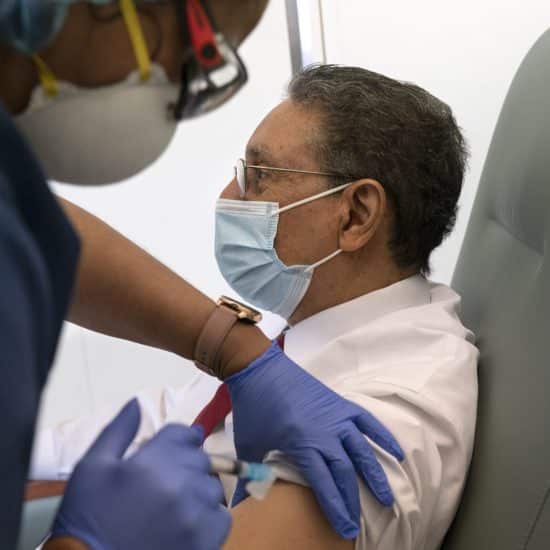As its neighborhood shifts, a congregation often chooses to sell its facility and relocate. Many times, church's members have moved to a different part of town and want a building close to where they live.
Members either give away or sell the facility to another church in the neighborhood, usually one that ministers to the area's largest ethnic group.
Blended community
A few congregations, however, choose to create something new by merging two distinct churches. But creating a blended Christian community takes work.

Pastors Lincoln Bingham (center left) and Mark Payton (center right), along with their wives, lead their newly united congregation in prayer in 2009. (PHOTO/David Winfrey)
|
St. Paul Baptist Church at Shively Heights in Louisville, Ky., drew national media attention when the historically black St. Paul Missionary Baptist and the predominately white Shively Heights Baptist merged to create the blended congregation in August 2009.
Pastor Lincoln Bingham of St. Paul Baptist reached out to Shively Heights' pastor, Mark Payton, when Payton moved to the area 26 years earlier. The two became close friends, and as more African-Americans moved into the area, the two began talking about ways to minister to their community.
The pair wanted to lead their congregations to minister. But St. Paul's didn't have the facilities it needed, and Shively Heights members didn't have the economic resources to cover the upkeep on its building. Bingham and Payton felt God showing them a merger would be the best way to reach a community of nearly 300,000 people—both black and white.
Merger hasn't been all that uncommon in the past 20 to 25 years, but often the result reverts to one primary culture, or a church will hold two distinct services to accommodate each culture. As co-pastors, Payton and Bingham have worked hard to lead the blended congregation to remain blended.
Currently, the church's makeup is about 60 percent black and 40 percent white. While the community is predominately African-American, the racial mix of new members since the merger has been about 50/50, with a few Hispanics and other minorities joining, as well.
The congregation works at keeping a blend, even in its programs and governance. All Sunday school classes have two teachers—one black and one white—who rotate responsibilities each month. Every committee has a balanced representation, and the pastor scheduled to preach isn't announced ahead of time. "They know who it is when they see the bulletin," Payton said with a laugh.
Members concentrate on ministry, with an organized evangelistic outreach every Monday night, Vacation Bible School each summer and an annual back-to-school block party. For the past three years, the church has offered a basketball league, attracting 500 to 600 participants and spectators each weekend during the season.
"We've really been amazed at how well it is working," Payton said. "We just tried to determine what God's will is. … We just don't think there's room for prejudice."
Slowly becoming one
Members of New Home Baptist Church in Kansas City believed God had called them to reach the unchurched in Kansas City. In 2010, the church had about 200 members, with about 75 percent African Americans and 25 percent other groups. But they quickly outgrew their building. To continue making an impact on the area, they needed more room.
The nearby Mount Washington Baptist Church had been a large urban congregation in its heyday in the 1960s. But by 2008, when Tom Renfro became pastor, the congregation had dwindled to about a dozen senior adults. "Our youth department was two people in their 60s," Renfro quipped. Everyone else had long been retired.
New Home's pastor, Clarence Newton, and Renfro began discussing possibilities. New Home needed the room Mount Washington had, and Mount Washing-ton needed a future. Members decided both visions could be realized by merging.
The new congregation, though, decided to maintain each culture's identity by offering two services—one traditional and one contemporary. The traditional service, which Renfro led, became the home of Caucasian members, while black members chose the contemporary service, with Newton preaching.
Last year, when church decided it no longer could afford two pastors, Renfro resigned. Both the traditional and contemporary services still are offered, with Newton preaching both services.
Each has become a little more blended as older blacks have chosen the traditional service and young whites have moved into the contemporary worship.
The church has baptized more than four dozen people since the merger.
Renfro anticipates Mount Washington will become a predominately black Baptist church in the near future.
"But overall, the merger has been a success because the building is being used, and the church is reaching people for Christ and moving forward," he said.






